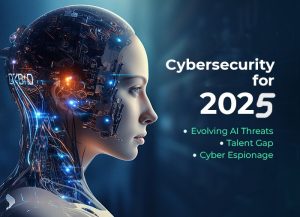Introduction Cyber threats grow smarter every year. In 2025, companies face attacks from hackers using advanced tools. To fight back, security teams need powerful defenses. That’s where AI algorithms cybersecurity comes in. These algorithms learn from data and spot threats faster than humans. This article explores the top breakthrough AI algorithms driving cybersecurity in 2025.
Introduction
Cyber threats grow smarter every year. In 2025, companies face attacks from hackers using advanced tools. To fight back, security teams need powerful defenses. That’s where AI algorithms cybersecurity comes in. These algorithms learn from data and spot threats faster than humans.
This article explores the top breakthrough AI algorithms driving cybersecurity in 2025. We explain what each algorithm does and why it matters. You will learn how machine learning threat detection, machine learning algorithms, behavior analytics security, and federated learning in security keep social media networks safe. We also cover generative AI security and wide range AI-driven incident response. By the end, you’ll know practical tips to strengthen your defenses using AI.
What Is AI in Cybersecurity?

Image by: Yandex.com
Artificial intelligence means computers perform specific tasks that once needed human thinking. In cybersecurity, AI studies network traffic, user habits, user experiences, and code patterns. It finds unusual behavior that could signal an attack.
Unlike simple rules, AI adapts as threats evolve. A rule-based system might block an IP address once. But a clever hacker can shift to a new address. AI systems learn new malicious patterns and update themselves. This constant learning gives security teams an edge.
AI also reduces alert fatigue. Instead of hundreds of daily alarms, it highlights the most serious risks. Teams can focus on true threats rather than chasing false positives. It turns vast data into clear action, making networks safer and response faster.
What Are Breakthrough AI Algorithms in 2025?

Image by: Yandex.com
By 2025, several AI methods stand out in cybersecurity. These include supervised machine learning modeling, unsupervised learning, behavior analytics, federated learning, and generative AI technology. Each brings unique strengths to threat anomaly detection and response.
Supervised machine learning uses labeled data. For example, it learns from past malware examples. It then spots similar code in new files. Unsupervised learning finds hidden patterns without labels. It detects anomalies that may indicate unknown attacks.
Behavior analytics security studies how users and devices normally act. It learns daily routines and flags odd actions, like a file download at midnight. Federated learning in security shares insights across organizations without exposing raw data analytics. This way, many firms benefit from AI deep learning models trained on diverse attacks.
Generative AI security creates synthetic attack scenarios. It tests defenses against novel threats, helping teams prepare before real hackers strike. Together, these clustering algorithms form a powerful shield for modern deep neural networks.
Role of AI in Everyday Security Operations

Image by: Yandex.com
In daily operations, AI now shapes how teams protect data, sensitive information and systems. Threat-detection engines use deep learning to examine emails, files, and traffic for hidden malware. AI-driven identity checks—like recognizing typing patterns or device traits—stop unauthorized logins. Incident-response tools suggest next steps, speeding up containment and recovery. Even phishing simulations use AI to craft realistic mock attacks and train employees. By weaving AI into each stage—from monitoring to response—security teams stay one step ahead of cybercriminals.
How AI is Improving Cybersecurity in 2025

Image by: Yandex.com
1. Machine Learning Threat Detection Works
At the heart of many systems is machine learning threat detection. It starts with data collection. Logs from firewalls, endpoints, and servers feed into an AI engine. This engine cleans and normalizes the data science, turning it into a format AI can use.
Next comes model training. Security experts label past events as safe or malicious. The machine learning ml AI learns the differences. Once trained, it scans live vast amounts of data for similar patterns. If it sees signs of known malware or phishing, it raises an alert.
Unsupervised models also help. They cluster input data into groups. Anything outside normal clusters triggers further review. This method is vital for spotting zero-day exploits that lack prior examples.
Finally, continuous learning keeps the model fresh. Security teams feed back confirmed threats and false alarms. The AI refines itself, reducing mistakes and staying sharp against new attack methods.
2. Behavior Analytics
Behavior analytics security focuses on user data and device habits. It learns normal work hours, login locations, and data access patterns. Most employees follow predictable routines. AI models capture these habits and build a baseline.
When someone logs in from a new country at an odd hour, behavior analytics flags it. Or if a printer normally used for small prints suddenly exports thousands of pages, the AI alerts the team. These insights catch insider threats and compromised accounts.
Behavioral data analytics also adapts over time. If a user moves to a new office, the AI learns the new patterns without manual updates. This flexibility makes behavior analytics a key tool in a multi-layered defense strategy.
3. Federated Learning in Security
Federated learning in security lets multiple organizations train AI models together without sharing private data. Each company trains the model on its own network logs. They then send only model updates, not raw logs, to a central server.
The server aggregates these updates into a global model. This global model learns from diverse environments—financial, healthcare, or retail—making it stronger at spotting varied attacks. Each participant benefits from broad knowledge while keeping data private.
Federated learning also reduces data transfer costs and meets regulatory rules. Firms can comply with privacy laws like GDPR while improving their cybersecurity posture through shared AI intelligence.
4. Generative AI for Security
Generative AI security uses models that can create new data. In cybersecurity, these models simulate attacks to test defenses. For example, a generative model might craft phishing emails with novel wording. Security teams then use these samples to train filters.
These AI-generated attacks help teams prepare for threats before they appear in the wild. They also help improve detection rules by showing edge-case scenarios.
Generative AI can also propose mitigation steps. When it spots unusual network traffic, it may suggest blocking a port or isolating a device. This proactive guidance speeds up response and reduces damage.
5. AI-Driven Incident Response
AI-driven incident response blends threat fraud detection with automated actions. When AI spots a breach, it can isolate the affected system, revoke compromised credentials, and block malicious IPs.
This immediacy limits the attack’s spread. It also buys time for human analysts to investigate. AI tools generate concise incident reports with root-cause analysis and suggested fixes.
By automating routine tasks, AI-driven response frees analysts to focus on complex problems. It also ensures that steps are taken consistently and quickly, even outside of business hours.
6. AI in Cloud Security
With more businesses moving to the cloud, securing cloud-based data is critical. AI algorithms are being used to monitor cloud environments for vulnerabilities and threats. They can quickly identify and fix security weaknesses, making cloud storage safer for businesses.
AI can also ensure that companies comply with security regulations, such as GDPR or HIPAA, by continuously monitoring cloud activity.
7. Predictive Analytics for Future Threats
Predictive analytics uses AI to look at past data and predict future threats. By analyzing patterns, AI can anticipate potential attacks, like ransomware or phishing attempts.
This type of AI-driven prediction allows businesses to prepare for attacks before they happen, making it easier to stop them in their tracks.
8. Automated Incident Response
Another advantage of AI is automated incident response. When a cyberattack is detected, AI algorithms can instantly take action. This includes blocking malicious traffic, isolating affected systems, or alerting security teams.
By automating responses, AI reduces the time it takes to contain a threat, making it easier to stop attacks before they escalate.
Tips to Implement AI Cybersecurity

Image by: Yandex.com
There are some tips to implement AI cybersecurity:
- Start with clear goals. Decide which threats you need to address first. Malware, phishing, insider risks, or IoT device attacks all differ.
- Next, choose a mix of algorithms. No single AI method solves every problem. Combine supervised learning for known threats and unsupervised models for anomalies.
- Ensure high-quality data. AI accuracy depends on clean, labeled logs. Invest time in data collection and labeling learning processes.
- Integrate AI with your security operations center. Automate alert triage and incident response steps. Use dashboards that highlight critical issues, not every minor alert.
- Regularly retrain models. Threats evolve, and so must your AI. Schedule weekly or monthly retraining using the latest data.
- Finally, train your team. AI tools help, but human insight remains vital. Teach analysts how to interpret AI findings and refine models with feedback.
Challenges of Using AI in Cybersecurity
Despite its power, AI also brings real hurdles for security teams. Quality data is key—if training sets are biased or incomplete, AI can miss threats or spit out false positives. Hackers may try to “poison” AI models by feeding them misleading data. Building and tuning AI systems demands skilled experts, who remain in short supply. Running advanced AI can also strain compute resources and budgets. Finally, overreliance on automation risks hiding errors; human oversight remains essential. Careful planning and regular audits help teams overcome these challenges.
Future of AI-Driven Cybersecurity Beyond 2025

Image by: Yandex.com
Looking ahead, AI in cybersecurity will grow even more proactive and intelligent. We can expect predictive models that spot weak points before hackers target them. AI assistants may draft and apply security patches automatically, closing gaps in real time. Federated learning could let organizations share threat insights without exposing private data. Explainable AI will help analysts understand why an alert flagged, building trust in automated informed decisions. As AI tools become easier to use and more transparent, they will form the backbone of every organization’s cyber defense.
Comparative Table: AI Cybersecurity Algorithms
| Algorithm Type | Key Function | Main Benefit |
|---|---|---|
| Supervised ML | Classify known malware and phishing | High accuracy on known threats |
| Unsupervised ML | Detect novel anomalies | Finds zero-day exploits |
| Behavior Analytics | Monitor user/device habits | Catches insider and account threats |
| Federated Learning | Train across orgs without data share | Broad threat insights, data privacy |
| Generative AI | Simulate new attack samples | Prepares defenses for unseen threats |
Conclusion
Breakthrough AI algorithms cybersecurity are reshaping defenses in 2025. From machine learning techniques or machine learning threat detection to behavior analytics security, these methods spot threats faster and more accurately. Federated learning in security shares knowledge without risking privacy. Generative artificial intelligence AI security tests defenses against new attacks. AI-driven incident response automates key steps, limiting damage with speed.
By combining these supervised learning algorithm, organizations build a resilient security posture. Start small, choose diverse AI tools, and maintain clean data points. With ongoing training and model updates, your defenses will stay one step ahead of attackers.
















